One of the most popular summer vegetables in our country is a cucumber. Far-sighted housewives salt and pickle vegetables for the winter, so that on New Year's Eve they can be added to traditional Olivier or simply put on the table with delicious potatoes.
Result growing cucumbers in open areas it is difficult to predict, it all depends on the weather. Resourceful gardeners build greenhouses and hotbeds of various materials on the sites. Cucumbers in a polycarbonate greenhouse ripen much faster, and bear fruit many times more. True, caring for such vegetables is slightly different from growing in open field.
Content
- 1 Advantages and features of growing cucumbers in polycarbonate greenhouses
- 2 Planting cucumbers in a polycarbonate greenhouse
- 3 Rules for the care of cucumbers in greenhouses made of polycarbonate
- 4 The formation of a bush of cucumbers in a greenhouse for beginners
- 5 Pest and Cucumber Disease Control
- 6 Common questions
Advantages and features of growing cucumbers in polycarbonate greenhouses
The construction of the greenhouse on the site is due to the climatic features of central Russia. Weather conditions are not always favorable for growing plants, which greatly affects the quality of vegetables. Growing cucumbers in a greenhouse has its advantages:
- Favorable conditions for growing plants controlled by the gardener himself.
- Less chance of infection of cucumbers with harmful insects and damage to plants by animals.
- Higher yield of vegetables.
- Protect plants from unwanted rain, wind and direct sun.
- Early ripening of fruits.
- Extension of the yield of vegetables.
- Growing plant hybrids adapted for warmer places.
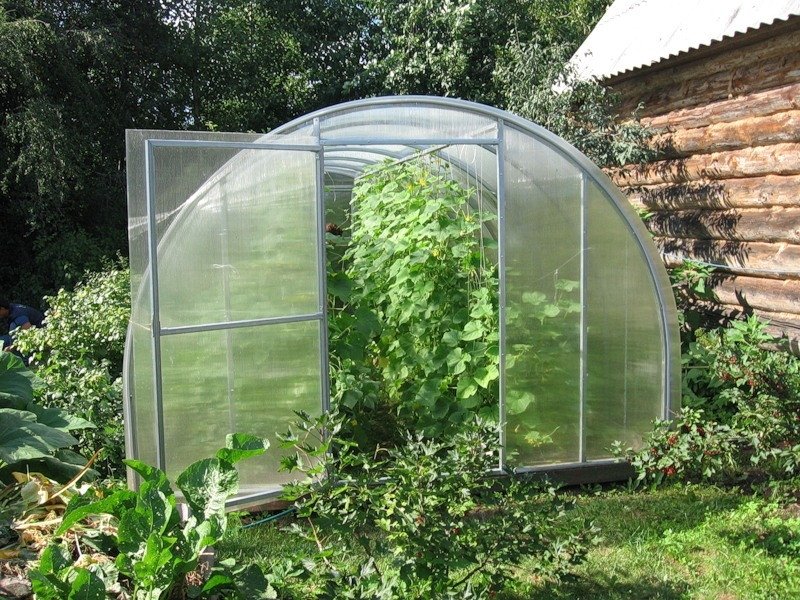
Polycarbonate is a new generation of material. Given the advantages and disadvantages of other materials, it undoubtedly stands an order of magnitude higher, having the following advantages:
- Under the cover of polycarbonate, vegetables receive a sufficient amount of light and at the same time are completely protected from exposure to sunlight, which reduces to zero the possible risk of leaf burns.
- Plastic consists of vacuum cells that provide additional thermal insulation.
- The material is flexible, so it is perfectly installed even on inappropriate places. There is no need to prepare a foundation for it.
- Due to its structure, polycarbonate can be installed even on sandy and clay soil.
- Plastic is strong and durable. It tolerates temperature extremes and more load.
Unlike polycarbonate, glass is heavier and more fragile. It cannot provide a good level of tightness. The film adheres more tightly, but it breaks the light, is not very durable and loses its integrity from the slightest damage.
Planting cucumbers in a polycarbonate greenhouse
Proper planting is the key to a good harvest. Mistakes made at this stage can lead to unpleasant consequences and disappointment.
General rules
When planting cucumbers, it is recommended to be guided by the following tips:
- Seeds must be of good quality. It is better to buy them from a trusted seller.
- Before planting, the seeds germinate, otherwise the germination rate will be less.
- Polycarbonate greenhouses are the only greenhouses where growing cucumbers from seeds is preferable to growing vegetables from seedlings.
- Seedlings are directed vertically, tying it to the supports.
- The earthen lump of the bush should protrude from the soil by 2 cm.
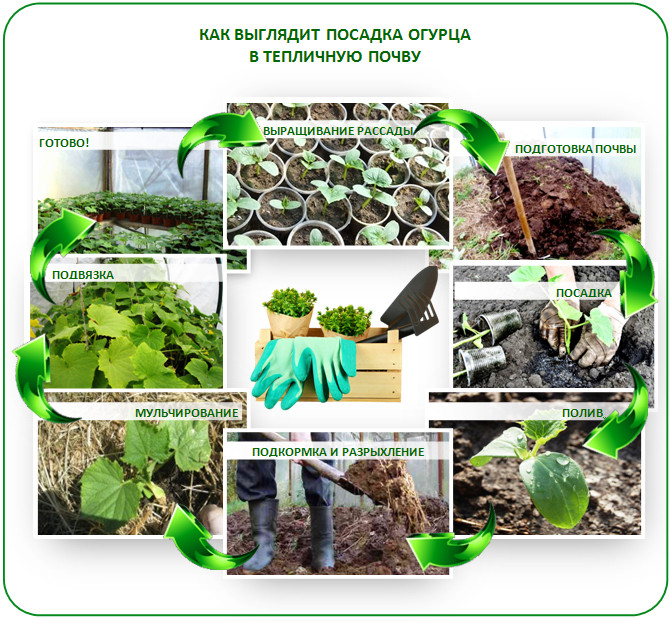
In order for pollination to be better, experienced gardeners plant different varieties of one vegetable next to each other.
Sowing seeds
Proper sowing of seeds of cucumbers involves such actions:
- Natural selection. For sowing, only large seeds are suitable without visible damage. And even among such seeds there are certainly dummies. In order not to waste space in the greenhouse on empty seeds, they are checked using salted water. Half an hour after the dive, all the pacifiers come up, and good seeds remain at the bottom.
- Drying out. Before the mandatory soaking procedure, experienced summer residents are advised to dry the seed. To do this, it is poured into a fabric bag and placed for a day above the heating device.
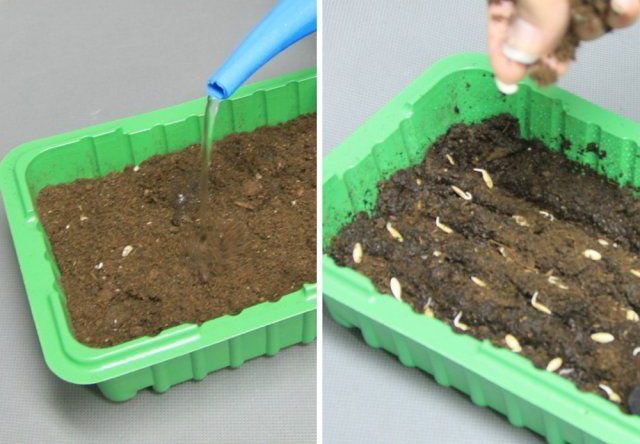
Sowing seeds - Soak. This procedure is carried out immediately before sowing. It is enough for cucumbers to lie in water for 10-12 hours.
- Germination. Planting material is wrapped in a damp cloth and left in a warm place for a day.
Seeds are planted in prepared wells to a depth of 1-2 cm. For very loose soil, the depth is increased to 3 cm. To save space, 3 seeds are placed in 1 cell.
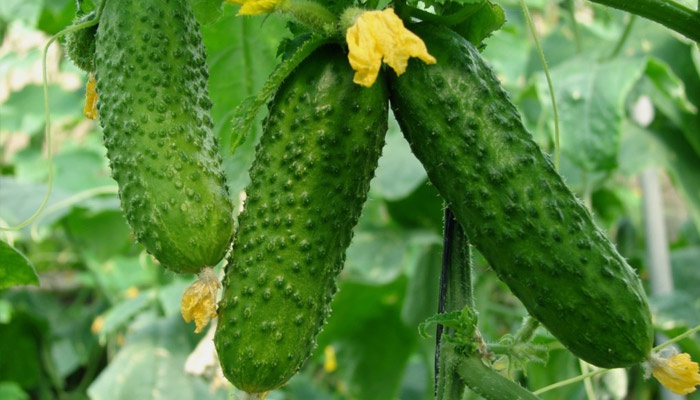 You may be interested in:
You may be interested in:Seedling method of planting
Seedling method allows to accelerate the harvest of cucumbers by 2 weeks. 25-day bushes are ready for planting, on which there are already 3-4 full-fledged leaves. On 1 m² there are no more than 4 plants.
When planting seedlings, it is very important to observe the temperature regime. The temperature in the greenhouse should be between + 20-22 ℃, and the temperature of the soil - + 16-18 ℃.
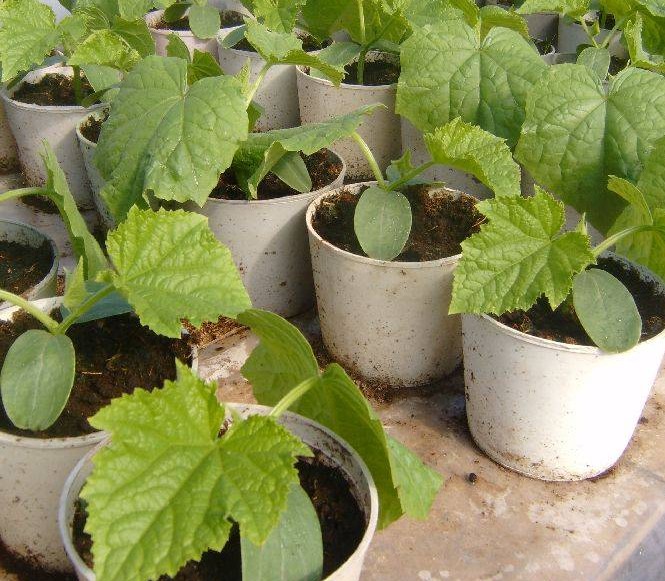
If the plants have outgrown, they should be planted at an angle. After planting, they begin a period of adaptation, during which overgrown cucumbers can break the stem under the weight of their own leaves.
Landing time
Conventionally, all cucumbers can be divided into such sorting groups:
- early
- mid-season;
- late.
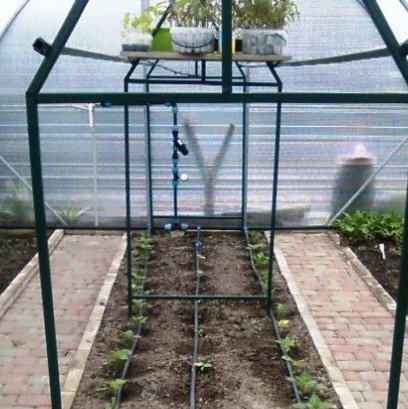
Based on this, experts recommend sowing seeds in such periods:
- March 15 - April 20. At this time, only early cucumbers are sown.
- 01.05 - 15.05. A favorable period for mid-season vegetables.
- 08.20 - 08.30. The end of August is the time for new generation hybrids that bear fruit until November.
To determine the timing of planting, it is also necessary to take into account the degree of heating of the soil and air. The temperature of the earth should not be lower than + 16 ℃, air - + 20 ℃.
Planting Schemes
In greenhouse conditions, a single-row, double-row and checkerboard landing order is used. The quantity and quality of the future crop depends on the correct choice of the scheme.
| Scheme | Varieties | Optimum distance on one bed, m | Between plants, m | Aisle, m | From bed to bed, m |
|---|---|---|---|---|---|
| Single row | High yield large-leaved species | 0,4-0,5 | 0,25-0,3 | — | 0,25-0,3 |
| Double row | Cucumbers with small leaves | 0,8-1 | 0,35-0,4 | 0,45-0,6 | 0,4-0,5 |
| Chess | Large-leaved species with large fruits | 0,8-0,9 | 0,35-0,4 | 0,55-0,6 | from 0.4 |
Each circuit has its own disadvantages and advantages. The most effective, in terms of space saving, is staggered landing.
Rules for the care of cucumbers in greenhouses made of polycarbonate
Growing cucumbers in greenhouse conditions provides special care for plants. During the period of budding and fruiting, greenhouse cucumbers require a special organization of watering and feeding.
Watering
Cucumbers are considered moisture-loving plants.Despite this, watering should be organized, because excessive moisture contributes to the development of rot.
When organizing watering, the following points should be considered:
- The soil under the plant should always be moist, however, water stagnation should not be allowed.
- Leaf wilting is unacceptable. At the first sign, the plant must be moistened.
- To speed up the process of forming the ovaries, cucumbers watered a little less during this period.
- Water temperature for irrigation should not be lower than + 18 ℃. But too hot water does not need to be used.
- After the irrigation procedure, the soil must be fluffed up.
The frequency of watering depends on the temperature in the greenhouse. At a moderate temperature, cucumbers are watered 2-3 times a week. If it is hot in the greenhouse, watering should be increased by performing the procedure every 2 days.
Top dressing
No matter how fertile the soil is, to get a good crop, plants need to be fertilized. At various times in the life cycle, cucumbers require a certain amount of food.
| Period | Necessary feed |
|---|---|
| After landing | Mullein mixture with superphosphate and potassium sulfate |
| Budding | Boric acid (5 g per 10 l of water) |
| First fruits | Nitrophoska |
| The midst of fruiting | A mixture of mullein with potassium sulfate |
It is important to strictly observe the dosage indicated in the fertilizer instructions. From a supersaturation by feeding, the root system of the plant may suffer.
In addition to fertilizers, cucumbers should be fed wood ash every 10 days. This fertilizer is indispensable for this crop. Ash is bred at the rate of 10 g per 1 liter of water.
 You may be interested in:
You may be interested in:The formation of a bush of cucumbers in a greenhouse for beginners
Experienced gardeners easily cope with the formation. For beginner growers, bush formation may seem complicated. In fact, it is worth only once to carry out the formation yourself, and in the future with this procedure there will be no difficulties.
Step-by-step instruction
In the process of growing cucumber bushes, they are constantly formed. This procedure is not only due to the saving of greenhouse space.
The formation of a cucumber bush involves the following procedures:
- Pasynkovka - removal of excess leaves and ovaries to ensure the normal functioning of the bush.
- Pinching - stopping the growth of shoots in favor of the stems remaining on the bush.
- Pruning - timely cleansing of the plant from dead wood.
Stepson
Stepsoning provides for such actions:
- In order to provide the stem with the necessary air exchange, all rudiments and leaves up to 4 plates are removed. This manipulation is also called the prevention of rot.
- When the plant reaches a height of 1 m, all unnecessary shoots and leaves are removed from it. You need to leave only 2-3 main shoots and a few good leaves.
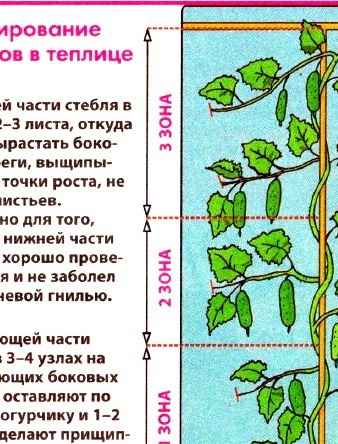
The scheme of formation of the cucumber stalk during stepsonovka - When the plant reaches 1.3 m, its shoots should not exceed 0.4 m. On each shoot, 2 ovaries and the same number of leaves are left.
- In one and a half meter cucumbers, the number of leaves and ovaries on the shoots is increased to 4.
The apical leaves are removed very carefully, since often they are closely adjacent to the main stem.
Topping
The nipping procedure involves trimming leaves and shoots in order to rationalize the nutrition of the bush. First of all, the lower inflorescences should be removed. Having formed at the bottom of the stem, they never transform into ovaries, but will take a significant proportion of nutrients from the bush.
To prevent overgrowth, pinch young shoots.The maximum allowable shoot length for nipping is 20 cm. Removing longer branches noticeably injures the bush.
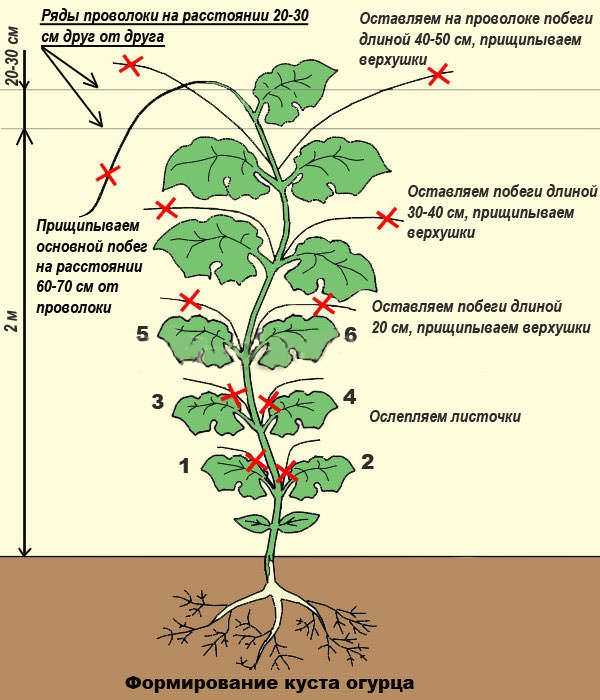
The third moment of pinching is to stop the growth of the main stem. Usually pinch the lashes 20 cm to the ground. You can trim the top earlier, then all the forces of the bush will be directed to the development of side shoots.
Pruning
Pruning cucumbers is sanitary in nature and consists in the timely removal of dead leaves and flowers, empty ovaries, damaged parts of the plant, including deformed fruits. Mandatory removal requires antennae.
It is better to cut bushes in the morning, so that the plant has time to recover in a day. Use only sharpened tools so as not to leave burrs on the bushes. Leaves cut as much as possible at the base. Leaving stumps of cuttings is not advisable, as they are often mildewed.
Pest and Cucumber Disease Control
Drying and curled leaves, spots, deformation of the fruits indicate the infection of cucumbers with pests or diseases. The most common cases of plant damage are as follows:
| Definition | Symptoms | Treatment | Prevention |
|---|---|---|---|
| Powdery mildew | White powdery coating on leaf plates | Treatment with mullein, potassium permanganate solution, infusion of onion peel, soap-soda solution | Timely weed removal, seasonal soil replacement |
| Root rot | Brown, drying stems, spotty drooping leaves, stunted growth | Processing a plant with a mixture of a solution of copper sulfate and wood ash | Compliance with temperature conditions, properly organized watering |
| Anthracosis | Yellow formations on the leaves and fruits of the plant, which eventually acquire a brown hue | Treatment with 1% solution of Bordeaux fluid, vitriol, ash | Compliance with the rules for the care of cucumbers |
| Spider mite | Leaves lose juice, flowers and buds fall | Garlic Water Treatment | Timely weed removal |
| Whitefly | Leaves lose juice, white sugar coating appears on them | Soap solution | |
| Aphid | Wrinkled or folded leaves, deformed inflorescences | Processing with soap and vinegar, spraying with water and pepper. |
Plant ailments are not always associated with infections and pests. Often, cucumbers suffer from poorly organized care.
Yellowing and drying of the leaf blades may result from fertilizer deficiency. Inadequate feeding, waterlogging of the soil and a violation of the temperature regime are also indicated by the dropping of ovaries and slow growth.
Common questions
Growing cucumbers in a polycarbonate greenhouse is easy.If you follow the advice of specialists, for the season you can collect several crops of healthy vegetables at once.




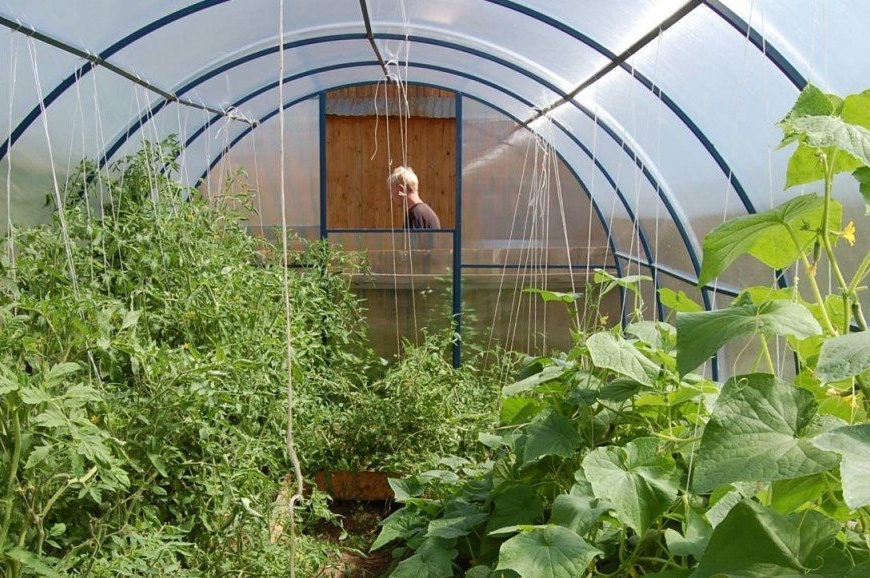
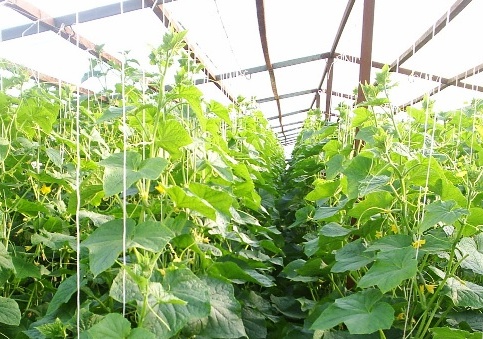
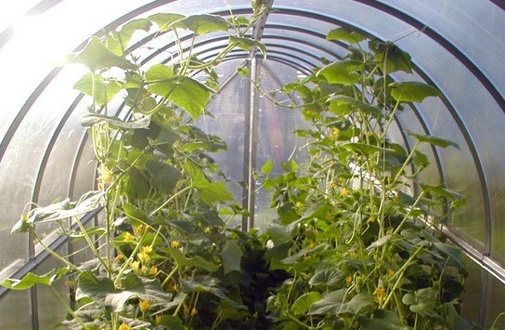
 Armenian cucumber with melon flavor: description and characteristics, reviews
Armenian cucumber with melon flavor: description and characteristics, reviews Do-it-yourself vertical beds for cucumbers: schemes, photos
Do-it-yourself vertical beds for cucumbers: schemes, photos Hollow cucumbers: reasons for the appearance of hollow, what to do
Hollow cucumbers: reasons for the appearance of hollow, what to do Which manure is best for cucumbers: application, how to breed
Which manure is best for cucumbers: application, how to breed